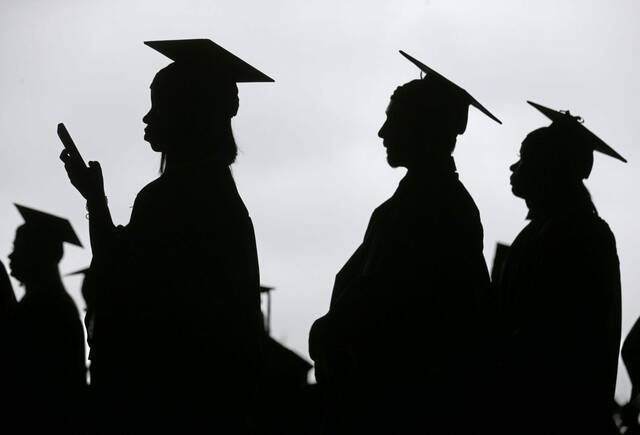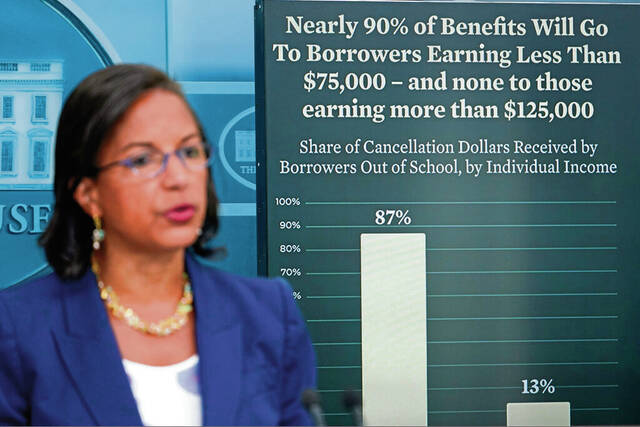Federal student loan forgiveness is welcomed in Westmoreland, but overdue for some
Virginia native Grace Merrbach was all smiles Wednesday when she learned of the student loan forgiveness program announced the same day by President Joe Biden.
“I’m very excited,” said the 21-year-old senior biology major at the University of Pittsburgh at Greensburg. “That gets rid of all of my student debt before I go on to medical school.”
Biden’s plan to forgive $10,000 in federal student loan debt for those with an income of less than $125,000 means Annie Quinn, a resident of Pittsburgh’s Greenfield neighborhood, also should be able to retire her student debt.
But the assistance is long overdue for Quinn, 38, a wife and mother of two. Since the Franklin Regional High School alumna earned undergraduate degrees in political science and environmental science from American University in 2006, she has been gradually paying down student loans totaling $120,000.
Quinn recently made the final payments on her private student loans. She has about $9,700 in remaining federal loan debt that she has vowed to pay off by the time she turns 40.
With the forgiveness program presented by Biden, she said, “It will be a cool present to be done two years ahead of time.”
But she’s not celebrating yet, given many previous promises of student debt assistance that didn’t pan out for her.
“I’ll believe it when I sign into the loan portal and see a zero in my account,” she said.
When Quinn was an undergraduate, she said, she didn’t realize the extreme financial burden she was taking on when she signed up for student loans. Meeting the requirements for a double degree added to her financial costs, she noted.
“When I was an 18-year-old, I was signing on for what would be the same as a really nice house,” she said. “I have built my career around, and had to to make incredible compromises because of, my student loans.”
Quinn, who works in water resource management, suffered an early career blow when she was laid off as a result of the Great Recession.
“I had $120,000 in debt going into the country’s biggest recession,” she said.
She said the only way she was able to earn a master’s degree in environmental management was to assume no more than a few thousand dollars in additional debt per semester.
Biden’s program provides an additional $10,000 in loan forgiveness for students who received Pell Grants.
Also, a pause on student loan payments is being extended through the end of the year.
That extended deadline provides some welcome breathing room for South Huntingdon native Kyle Harper, who received his Pitt-Greensburg degree in communications and creative writing this past spring.
“I haven’t started making payments, so that’s awesome,” said Harper, who is employed as a resident director at the campus.
Harper welcomed the $10,000 forgiveness, noting his student debt reaches into five figures.
“I grew up in a middle-class household,” he said. “Every cent helps.”
“I think it’s wonderful,” Pitt-Greensburg junior and Washington, D.C., resident Sarah Luffy said of the announced debt forgiveness.
The nursing student expects to have a debt of at least $50,000 to pay off when she receives her undergraduate degree, even though she’s had support from her parents during her first two years at the university.
“School is really expensive and things are really hard right now,” she said, “so any relief we can have can be the difference between having an education or not.”
University President Robert Gregerson said the average Pitt-Greensburg student graduates with $27,000 in student loan debt.
For those qualifying for the $10,000 forgiveness, “That would forgive more than a third of their student loans,” Gregerson said. “For many folks, that could be a tremendous benefit.”
He noted 42% of Pitt-Greensburg students are Pell Grant recipients, which could subtract even more from their outstanding debt.
More than 43 million people have federal student debt, with an average balance of $37,667, according to federal data. Nearly a third of borrowers owe less than $10,000, and about half owe less than $20,000.
At Greensburg’s private Seton Hill University, campus officials said students leave with an average federal loan debt that falls below the national average for private, nonprofit institutions of higher learning. According to educationdata.org, that average was $33,900 as of July 2021.
In June 2021, 64% of new Seton Hill graduates had federal loan debt, down from 84% in June 2018. During the past decade, between 30% and 40% of the university’s undergraduates received Pell Grants.
Jennifer Reeger, Seton Hill’s director of communications and media relations, said the loan forgiveness program can be especially helpful “for those who have chosen majors that might not lend themselves to high-paying positions but that are important in our society — such as social work, education and careers in nonprofits.”
Jeff Himler is a TribLive reporter covering Greater Latrobe, Ligonier Valley, Mt. Pleasant Area and Derry Area school districts and their communities. He also reports on transportation issues. A journalist for more than three decades, he enjoys delving into local history. He can be reached at jhimler@triblive.com.
Remove the ads from your TribLIVE reading experience but still support the journalists who create the content with TribLIVE Ad-Free.


